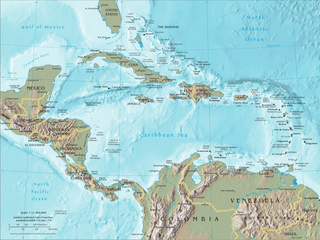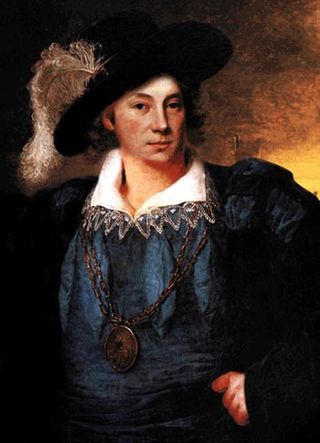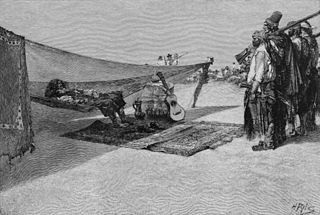
Buccaneers were a kind of privateer or free sailors particular to the Caribbean Sea during the 17th and 18th centuries. First established on northern Hispaniola as early as 1625, their heyday was from the Restoration in 1660 until about 1688, during a time when governments in the Caribbean area were not strong enough to suppress them.

Sir Henry Morgan born Harri Morgan was a Welsh privateer, plantation owner, and, later, Lieutenant Governor of Jamaica. From his base in Port Royal, Jamaica, he raided settlements and shipping on the Spanish Main, becoming wealthy as he did so. With the prize money from the raids, he purchased three large sugar plantations on the island.

The era of piracy in the Caribbean began in the 1500s and phased out in the 1830s after the navies of the nations of Western Europe and North America with colonies in the Caribbean began combating pirates. The period during which pirates were most successful was from the 1660s to the 1730s. Piracy flourished in the Caribbean because of the existence of pirate seaports such as Port Royal in Jamaica, Tortuga in Haiti, and Nassau in the Bahamas. Piracy in the Caribbean was part of a larger historical phenomenon of piracy, as it existed close to major trade and exploration routes in almost all the five oceans.

Tortuga Island is a Caribbean island that forms part of Haiti, off the northwest coast of Hispaniola. It constitutes the commune of Île de la Tortue in the Port-de-Paix arrondissement of the Nord-Ouest department of Haiti.
This timeline of the history of piracy in the 1680s is a chronological list of key events involving pirates between 1680 and 1689.

Jean-David Nau, better known as François l'Olonnais, was a French pirate active in the Caribbean during the 1660s.

The Golden Age of Piracy is a common designation for the period between the 1650s and the 1730s, when maritime piracy was a significant factor in the histories of the North Atlantic and Indian Oceans.
François or Francis Le Clerc, known as "Jambe de Bois", was a 16th-century French privateer, originally from Normandy. He is credited as the first pirate in the modern era to have a "peg leg".

Laurens Cornelis Boudewijn de Graaf was a Dutch pirate, mercenary, and naval officer in the service of the French colony of Saint-Domingue during the late 17th and early 18th century.
Daniel Johnson (1629–1675) was an English buccaneer who, serving under buccaneers such as Moyse Van Vin and Pierre le Picard, sailed against the Spanish during the late 17th century, becoming known among the Spanish as "Johnson the Terror". There is little record of his career aside from a single body of work, Appleton's Cyclopædia of American Biography (1887), suggesting he may be a fictional character.

Edward Davis or Davies was an English buccaneer active in the Caribbean during the 1680s and would lead successful raids against Leon and Panama in 1685, the latter considered one of the last major buccaneer raids against a Spanish stronghold. Much of his career was later recorded by writer William Dampier in A New Voyage Round the World (1697).

The Brethren or Brethren of the Coast were a loose coalition of pirates and buccaneers that were active in the seventeenth and eighteenth centuries in the Atlantic Ocean, Caribbean Sea, and Gulf of Mexico. They mostly operated in two locations, the island of Tortuga off the coast of Haiti and in the city of Port Royal on the island of Jamaica.

Edward Mansvelt or Mansfield was a 17th-century Dutch corsair and buccaneer who, at one time, was acknowledged as an informal chieftain of the "Brethren of the Coast". He was the first to organise large scale raids against Spanish settlements, tactics which would be utilised to attack Spanish strongholds by later buccaneers in future years, and held considerable influence in Tortuga and Port Royal. He was widely considered one of the finest buccaneers of his day and, following his death, his position was assumed by his protégé and vice-admiral, Henry Morgan.

Pierre le Picard (1624–1690?) was a 17th-century French buccaneer. He was both an officer to l'Olonnais as well as Sir Henry Morgan, most notably taking part in his raids at Maracaibo and Panama, and may have been one of the first buccaneers to raid shipping on both the Caribbean and Pacific coasts.

Bartolomeu Português (1623–1670) was a Portuguese buccaneer who attacked Spanish shipping in the late 1660s. Português was responsible for the creation of the first "Pirate's Code".
Francois Groginet was a French buccaneer and pirate active against the Pacific coast of Spanish Central America.
Jean L’Escuyer was a French pirate active on the Pacific coast of Central America. He sailed and fought alongside a number of prominent buccaneers such as Edward Davis, Francois Grogniet, William Dampier, and others.

Alexandre Bras-de-Fer was a flibustier in the latter half of the mid-17th century. He is best known for capturing a Spanish ship after being shipwrecked, though his story is possibly apocryphal.

Pierre Francois was a mid-17th-century flibustier, or French buccaneer, active in the Caribbean. He is best known for a single attack on a Spanish pearl-diving fleet. His story appears only in Alexandre Exquemelin's History of the Buccaneers and the truth of his account is uncertain.

Michel le Basque was a pirate and flibustier from the Kingdom of Navarre in the southwest of France. He is best known as a companion of François L'Olonnais, with whom he sacked Maracaibo and Gibraltar.

















